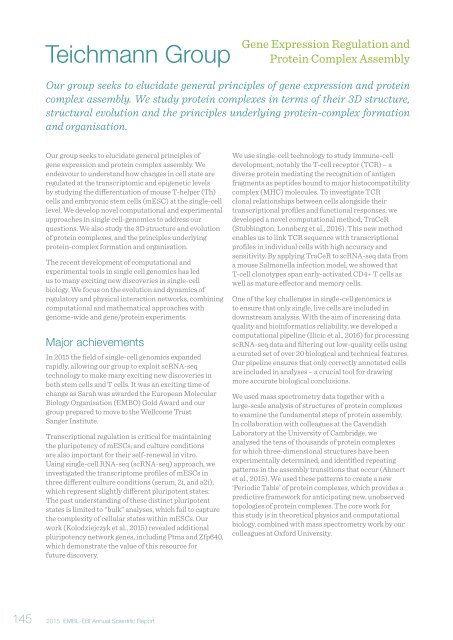Annual Scientific Report 2015
EMBL_EBI_ASR_2015_DigitalEdition
EMBL_EBI_ASR_2015_DigitalEdition
Create successful ePaper yourself
Turn your PDF publications into a flip-book with our unique Google optimized e-Paper software.
Teichmann Group<br />
Gene Expression Regulation and<br />
Protein Complex Assembly<br />
Our group seeks to elucidate general principles of gene expression and protein<br />
complex assembly. We study protein complexes in terms of their 3D structure,<br />
structural evolution and the principles underlying protein-complex formation<br />
and organisation.<br />
Our group seeks to elucidate general principles of<br />
gene expression and protein complex assembly. We<br />
endeavour to understand how changes in cell state are<br />
regulated at the transcriptomic and epigenetic levels<br />
by studying the differentiation of mouse T-helper (Th)<br />
cells and embryonic stem cells (mESC) at the single-cell<br />
level. We develop novel computational and experimental<br />
approaches in single cell-genomics to address our<br />
questions. We also study the 3D structure and evolution<br />
of protein complexes, and the principles underlying<br />
protein-complex formation and organisation.<br />
The recent development of computational and<br />
experimental tools in single cell genomics has led<br />
us to many exciting new discoveries in single-cell<br />
biology. We focus on the evolution and dynamics of<br />
regulatory and physical interaction networks, combining<br />
computational and mathematical approaches with<br />
genome-wide and gene/protein experiments.<br />
Major achievements<br />
In <strong>2015</strong> the field of single-cell genomics expanded<br />
rapidly, allowing our group to exploit scRNA-seq<br />
technology to make many exciting new discoveries in<br />
both stem cells and T cells. It was an exciting time of<br />
change as Sarah was awarded the European Molecular<br />
Biology Organisation (EMBO) Gold Award and our<br />
group prepared to move to the Wellcome Trust<br />
Sanger Institute.<br />
Transcriptional regulation is critical for maintaining<br />
the pluripotency of mESCs, and culture conditions<br />
are also important for their self-renewal in vitro.<br />
Using single-cell RNA-seq (scRNA-seq) approach, we<br />
investigated the transcriptome profiles of mESCs in<br />
three different culture conditions (serum, 2i, and a2i),<br />
which represent slightly different pluripotent states.<br />
The past understanding of these distinct pluripotent<br />
states is limited to “bulk” analyses, which fail to capture<br />
the complexity of cellular states within mESCs. Our<br />
work (Kolodziejczyk et al., <strong>2015</strong>) revealed additional<br />
pluripotency network genes, including Ptma and Zfp640,<br />
which demonstrate the value of this resource for<br />
future discovery.<br />
We use single-cell technology to study immune-cell<br />
development, notably the T-cell receptor (TCR) – a<br />
diverse protein mediating the recognition of antigen<br />
fragments as peptides bound to major histocompatibility<br />
complex (MHC) molecules. To investigate TCR<br />
clonal relationships between cells alongside their<br />
transcriptional profiles and functional responses, we<br />
developed a novel computational method, TraCeR<br />
(Stubbington, Lonnberg et al., 2016). This new method<br />
enables us to link TCR sequence with transcriptional<br />
profiles in individual cells with high accuracy and<br />
sensitivity. By applying TraCeR to scRNA-seq data from<br />
a mouse Salmonella infection model, we showed that<br />
T-cell clonotypes span early-activated CD4+ T cells as<br />
well as mature effector and memory cells.<br />
One of the key challenges in single-cell genomics is<br />
to ensure that only single, live cells are included in<br />
downstream analysis. With the aim of increasing data<br />
quality and bioinformatics reliability, we developed a<br />
computational pipeline (Ilicic et al., 2016) for processing<br />
scRNA-seq data and filtering out low-quality cells using<br />
a curated set of over 20 biological and technical features.<br />
Our pipeline ensures that only correctly annotated cells<br />
are included in analyses – a crucial tool for drawing<br />
more accurate biological conclusions.<br />
We used mass spectrometry data together with a<br />
large-scale analysis of structures of protein complexes<br />
to examine the fundamental steps of protein assembly.<br />
In collaboration with colleagues at the Cavendish<br />
Laboratory at the University of Cambridge, we<br />
analysed the tens of thousands of protein complexes<br />
for which three-dimensional structures have been<br />
experimentally determined, and identified repeating<br />
patterns in the assembly transitions that occur (Ahnert<br />
et al., <strong>2015</strong>). We used these patterns to create a new<br />
‘Periodic Table’ of protein complexes, which provides a<br />
predictive framework for anticipating new, unobserved<br />
topologies of protein complexes. The core work for<br />
this study is in theoretical physics and computational<br />
biology, combined with mass spectrometry work by our<br />
colleagues at Oxford University.<br />
145<br />
<strong>2015</strong> EMBL-EBI <strong>Annual</strong> <strong>Scientific</strong> <strong>Report</strong>


